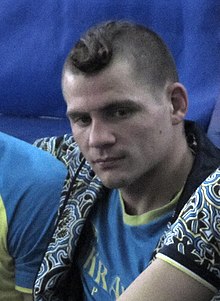Oseledets
This article needs additional citations for verification. (December 2009) |

| Part of a series on |
| Cossacks |
|---|
 |
| Cossack hosts |
| Other Cossack groups |
| History |
| Notable Cossacks |
| Cossack terms |
Oseledets (Ukrainian: оселедець, IPA: [oseˈlɛdetsʲ]) or chub (чуб [tʃub]) is a traditional Ukrainian hairstyle that features a long lock of hair sprouting from the top or the front of an otherwise closely shaven head (similar to a modern Mohawk). Most commonly it is associated with the Ukrainian cossacks.
History[edit]

A closely related haircut, czupryna, was worn by the Wends of early medieval Poland, and later by the Szlachta from the 12th until the 18th century.[citation needed]
During the 16th and 17th century, the Cossacks of Ukraine shaved their heads, leaving a long central strip which was often braided or tied in a topknot.[citation needed]

The oseledets underwent a revival among romantics and nationalists during the early 20th century.
After independence, the oseledets made a comeback among modern Ukrainians. It was seen during the Euromaidan protests of 2014.[1]
The Ukrainian name for this type of haircut is oseledets (Ukrainian: оселедець, literally "herring") or chub (Ukrainian: чуб, meaning "crest"). There are several Ukrainian surnames derived from this word.
The oseledets/khokhol is a standard feature in the stereotypical image of a Ukrainian Cossack.[citation needed] This haircut is depicted in various motion pictures such as The Lost Letter that is based on works of Nikolai Gogol.
Khokhol[edit]
Historically, Ukrainians used the term khokhol amongst themselves as a form of ethnic self-identification to visibly separate themselves from Russians.[2]
A Russian name for the oseledets hairstyle, khokhol (Russian: хохол, IPA: [xɐˈxol] is commonly used as an ethnic slur for a Ukrainian male (feminine form: Russian: хохлушка, romanized: khokhlushka),[3][4][5] as it was a common haircut of Ukrainian Cossacks. The term is usually derogatory or condescending.[6][7] The word comes from Proto-Slavic xoxolъ < *koxolъ, lit. 'crest, tuft'.[8] Accordingly, Khokhliandiya (Russian: Хохляндия, Хохландия) and Khokhlostan (Russian: Хохлостан) are derogatory references to Ukraine.[9]
See also[edit]
- List of hairstyles (with illustrations)
References[edit]
- ^ Kozlowska, Hanna (27 January 2014). "'Cossack' at the Heart of Kiev Protests Refuses to Give In". Foreign Policy.
- ^ Plokhy, Serhii (2008). Ukraine and Russia: Representations of the Past. University of Toronto Press. pp. 139–141. ISBN 978-0-8020-9327-1. Retrieved 1 February 2017.
Ethnic identity became the basis for differentiating between 'one's own' from 'foreigners.' Alekseev's use of the terms 'Russians' and 'Ukrainians' - terms of modern national identity - was rooted in concepts characteristic of the revolutionary and postrevolutionary era. His own records, as well as those of other contemporary authors, attest that the names most often used by peasants of the prerevolutionary era with reference to ethnic Ukrainians and Russians were khokhly (referring to Cossack topknots) and katsapy (a derogatory term). These terms, which hardly excluded negative connotations, were used to denote the two ethnic groups faute de mieux: as Rubel's own 'History' attests, Ukrainians used khokhol, inter alia, as a self-definition.
- ^ Laitin, David D. (1998). Identity in Formation: The Russian-speaking Populations in the Near Abroad. Cornell University Press. p. 175. ISBN 9780801484957.
- ^ "Євген Наконечний. Украдене ім'я. - [22] Хахол". exlibris.org.ua. Retrieved 2022-03-30.
- ^ "Стр. 796". vasmer.narod.ru. Retrieved 2022-03-30.
- ^ "Інститут мовознавства ім. О.О.Потебні | Словник української мови". www.inmo.org.ua. Retrieved 2022-03-30.
- ^ Thompson, Ewa M. (1991). The Search for Self-Definition in Russian Literature. John Benjamins Publishing Company. p. 22. ISBN 978-90-272-7759-6. Retrieved 10 October 2016.
- ^ Mel’nychuk, O. S. (1982–2012). Etymolohichnyĭ slovnyk ukraïnsʼkoï movy [Etymological dictionary of the Ukrainian language]. Vol. 6. Kiev: Naukova Dumka. pp. 205–6. ISBN 978-966-00-0197-8.
- ^ Bierich, Alexander (2009). Varietaeten Im Slavischen- Су стандартные варианты славянских языков: Ausgewaehlte Beitraege - Избранные статьи (in Russian). Peter Lang. ISBN 978-3-631-57010-4.
Bibliography[edit]
- Хохол // Словник української мови : в 11 т. — К. : Наукова думка, 1970–1980.
- (рос.)Андрей Моченов, Сергей Никулин. «Хохлы», «пиндосы», «чухонцы» и прочие «бусурмане» в Рунете и российской прессе. 28 июня 2006. MCK
- (рос.)Заява національно-культурної автономії українців Новосибірську
- Хахол // Украдене ім'я: Чому русини стали українцями / Є. П. Наконечний; Передмова Я. Дашкевича. — 3-є, доп. і випр. вид. — Львів, 2001. — 400 с. — ISBN 966-02-1895-8
- (рос.)Етимологічний словник Фасмера стор.796
- Ставицька Леся. Українська лексика в російському та польському жаргонно-сленговому вокабулярі / Александр Бирих (нім. Alexander Bierich) // Субстандартные варианты славянских языков. — Київ : Peter Lang. Internationaler Verlag der Wissenschaften, 2008. — № 17 (Серпень). — С. 198. — ISSN 0930-7281. — ISBN 978-3-631-57010-4
- Хохо́л // Етимологічний словник української мови : у 7 т. : т. 6 / редкол.: О. С. Мельничук (гол. ред.) та ін. — К. : Наукова думка, 2012. — Т. 6 : У — Я. — С. 205–206. — ISBN 978-966-00-0197-8
- Хохол // Українська мала енциклопедія : 16 кн. : у 8 т. / проф. Є. Онацький. — Накладом Адміністратури УАПЦ в Аргентині. — Буенос-Айрес, 1967. — Т. 8, кн. XVI : Літери Уш — Я. — С. 2017. — 1000 екз.
- Б. Н. Флоря. О значении термина «Хохол» и производных от него в русских источниках первой половины XVII в. (эпизод из истории русско-польско-украинских контактов) // STUDIA POLONICA. К 60-летию Виктора Александровича Хорева. М.: Институт славяноведения и балканистики РАН, 1992.(рос.)
